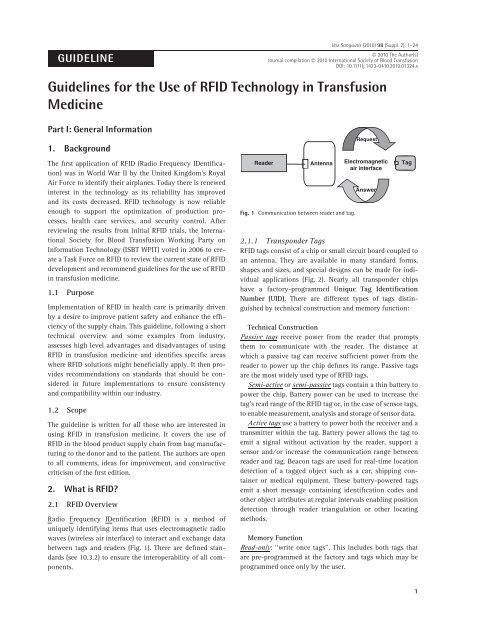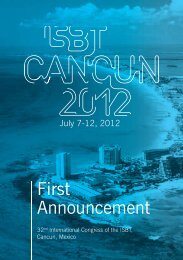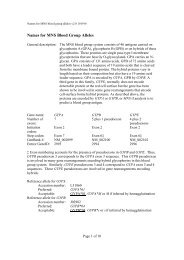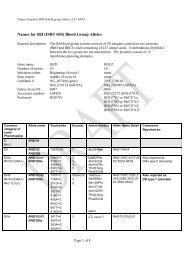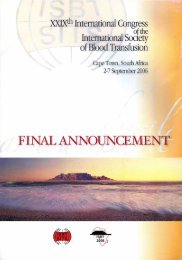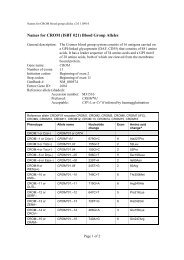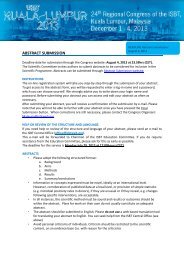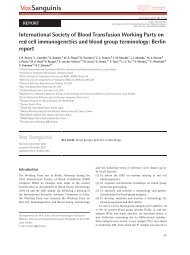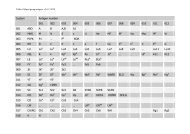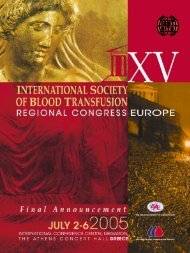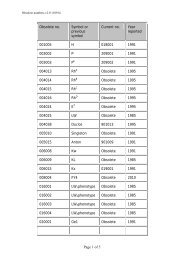Guidelines for the Use of RFID Technology in Transfusion Medicine
Guidelines for the Use of RFID Technology in Transfusion Medicine
Guidelines for the Use of RFID Technology in Transfusion Medicine
Create successful ePaper yourself
Turn your PDF publications into a flip-book with our unique Google optimized e-Paper software.
GUIDELINEVox Sangu<strong>in</strong>is (2010) 98 (Suppl. 2): 1–24ª 2010 The Author(s)Journal compilation ª 2010 International Society <strong>of</strong> Blood <strong>Transfusion</strong>DOI: 10.1111/j.1423-0410.2010.01324.x<strong>Guidel<strong>in</strong>es</strong> <strong>for</strong> <strong>the</strong> <strong>Use</strong> <strong>of</strong> <strong>RFID</strong> <strong>Technology</strong> <strong>in</strong> <strong>Transfusion</strong>Medic<strong>in</strong>ePart I: General In<strong>for</strong>mation1. BackgroundThe first application <strong>of</strong> <strong>RFID</strong> (Radio Frequency IDentification)was <strong>in</strong> World War II by <strong>the</strong> United K<strong>in</strong>gdom’s RoyalAir Force to identify <strong>the</strong>ir airplanes. Today <strong>the</strong>re is renewed<strong>in</strong>terest <strong>in</strong> <strong>the</strong> technology as its reliability has improvedand its costs decreased. <strong>RFID</strong> technology is now reliableenough to support <strong>the</strong> optimization <strong>of</strong> production processes,health care services, and security control. Afterreview<strong>in</strong>g <strong>the</strong> results from <strong>in</strong>itial <strong>RFID</strong> trials, <strong>the</strong> InternationalSociety <strong>for</strong> Blood <strong>Transfusion</strong> Work<strong>in</strong>g Party onIn<strong>for</strong>mation <strong>Technology</strong> (ISBT WPIT) voted <strong>in</strong> 2006 to createa Task Force on <strong>RFID</strong> to review <strong>the</strong> current state <strong>of</strong> <strong>RFID</strong>development and recommend guidel<strong>in</strong>es <strong>for</strong> <strong>the</strong> use <strong>of</strong> <strong>RFID</strong><strong>in</strong> transfusion medic<strong>in</strong>e.1.1 PurposeImplementation <strong>of</strong> <strong>RFID</strong> <strong>in</strong> health care is primarily drivenby a desire to improve patient safety and enhance <strong>the</strong> efficiency<strong>of</strong> <strong>the</strong> supply cha<strong>in</strong>. This guidel<strong>in</strong>e, follow<strong>in</strong>g a shorttechnical overview and some examples from <strong>in</strong>dustry,assesses high level advantages and disadvantages <strong>of</strong> us<strong>in</strong>g<strong>RFID</strong> <strong>in</strong> transfusion medic<strong>in</strong>e and identifies specific areaswhere <strong>RFID</strong> solutions might beneficially apply. It <strong>the</strong>n providesrecommendations on standards that should be considered<strong>in</strong> future implementations to ensure consistencyand compatibility with<strong>in</strong> our <strong>in</strong>dustry.1.2 ScopeThe guidel<strong>in</strong>e is written <strong>for</strong> all those who are <strong>in</strong>terested <strong>in</strong>us<strong>in</strong>g <strong>RFID</strong> <strong>in</strong> transfusion medic<strong>in</strong>e. It covers <strong>the</strong> use <strong>of</strong><strong>RFID</strong> <strong>in</strong> <strong>the</strong> blood product supply cha<strong>in</strong> from bag manufactur<strong>in</strong>gto <strong>the</strong> donor and to <strong>the</strong> patient. The authors are opento all comments, ideas <strong>for</strong> improvement, and constructivecriticism <strong>of</strong> <strong>the</strong> first edition.2. What is <strong>RFID</strong>?2.1 <strong>RFID</strong> OverviewRadio Frequency IDentification (<strong>RFID</strong>) is a method <strong>of</strong>uniquely identify<strong>in</strong>g items that uses electromagnetic radiowaves (wireless air <strong>in</strong>terface) to <strong>in</strong>teract and exchange databetween tags and readers (Fig. 1). There are def<strong>in</strong>ed standards(see 10.3.2) to ensure <strong>the</strong> <strong>in</strong>teroperability <strong>of</strong> all components.ReaderAntennaFig. 1 Communication between reader and tag.RequestElectromagneticair <strong>in</strong>terfaceAnswerTag2.1.1 Transponder Tags<strong>RFID</strong> tags consist <strong>of</strong> a chip or small circuit board coupled toan antenna. They are available <strong>in</strong> many standard <strong>for</strong>ms,shapes and sizes, and special designs can be made <strong>for</strong> <strong>in</strong>dividualapplications (Fig. 2). Nearly all transponder chipshave a factory-programmed Unique Tag IdentificationNumber (UID). There are different types <strong>of</strong> tags dist<strong>in</strong>guishedby technical construction and memory function:Technical ConstructionPassive tags receive power from <strong>the</strong> reader that prompts<strong>the</strong>m to communicate with <strong>the</strong> reader. The distance atwhich a passive tag can receive sufficient power from <strong>the</strong>reader to power up <strong>the</strong> chip def<strong>in</strong>es its range. Passive tagsare <strong>the</strong> most widely used type <strong>of</strong> <strong>RFID</strong> tags.Semi-active or semi-passive tags conta<strong>in</strong> a th<strong>in</strong> battery topower <strong>the</strong> chip. Battery power can be used to <strong>in</strong>crease <strong>the</strong>tag’s read range <strong>of</strong> <strong>the</strong> <strong>RFID</strong> tag or, <strong>in</strong> <strong>the</strong> case <strong>of</strong> sensor tags,to enable measurement, analysis and storage <strong>of</strong> sensor data.Active tags use a battery to power both <strong>the</strong> receiver and atransmitter with<strong>in</strong> <strong>the</strong> tag. Battery power allows <strong>the</strong> tag toemit a signal without activation by <strong>the</strong> reader, support asensor and ⁄ or <strong>in</strong>crease <strong>the</strong> communication range betweenreader and tag. Beacon tags are used <strong>for</strong> real-time locationdetection <strong>of</strong> a tagged object such as a car, shipp<strong>in</strong>g conta<strong>in</strong>eror medical equipment. These battery-powered tagsemit a short message conta<strong>in</strong><strong>in</strong>g identification codes ando<strong>the</strong>r object attributes at regular <strong>in</strong>tervals enabl<strong>in</strong>g positiondetection through reader triangulation or o<strong>the</strong>r locat<strong>in</strong>gmethods.Memory FunctionRead-only: ‘‘write once tags’’. This <strong>in</strong>cludes both tags thatare pre-programmed at <strong>the</strong> factory and tags which may beprogrammed once only by <strong>the</strong> user.1


